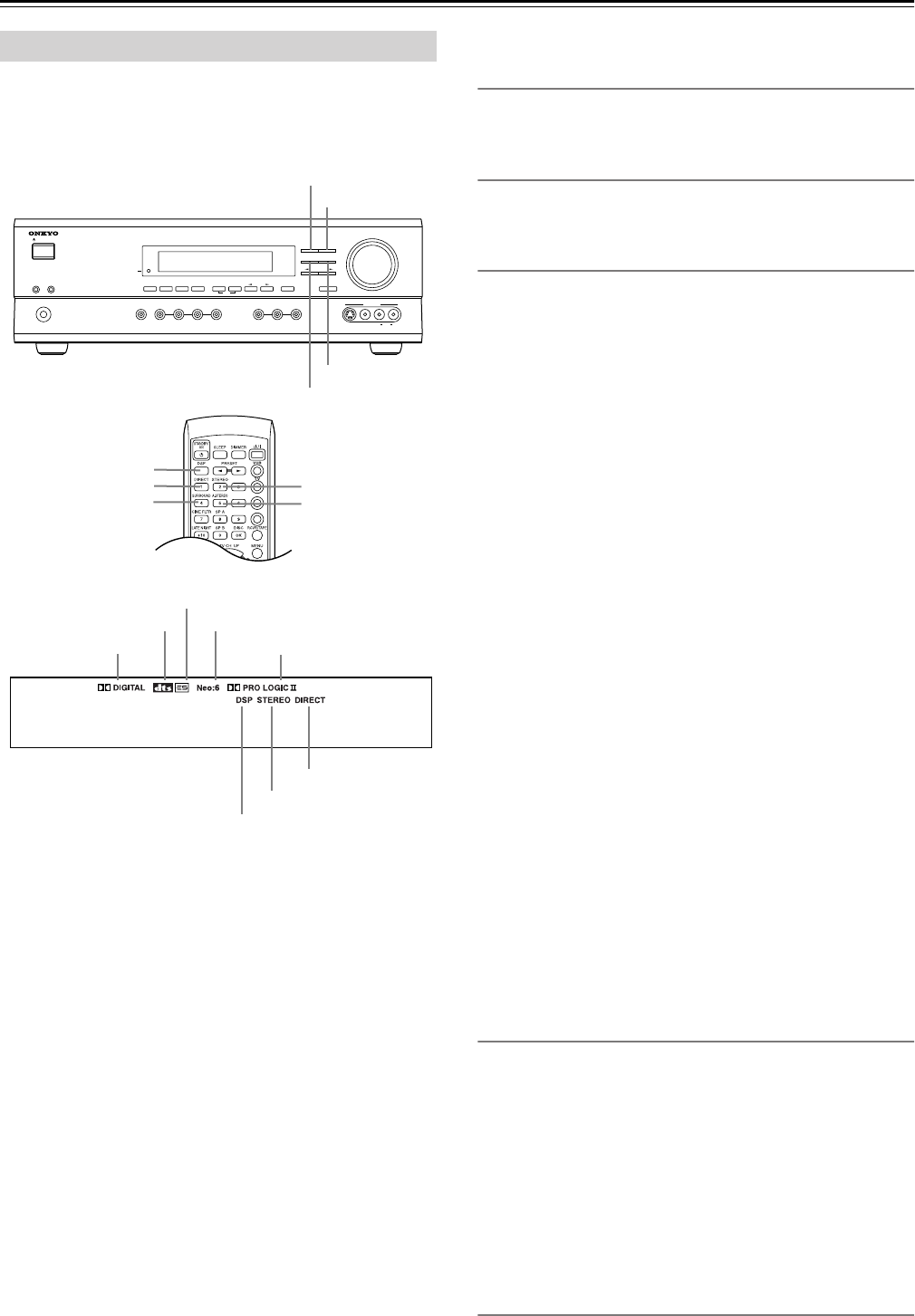
36
Using the Listening Modes—Continued
You can select the listening modes by using the following
buttons: [DIRECT], [STEREO], [SURROUND], [DSP], and
[A.STEREO] (the last button is available only on the remote
controller).
Listening mode availability depends on the format of the
currently selected input signal and the number of speak-
ers that you are using. If you use less than the minimum
number of speakers, some modes will not be available.
See “About the Listening Modes” on page 34 for more
information.
Notes:
•You cannot select a listening mode when the Multich input
source is selected. See “Using the Multi-Channel Inputs”
on page 29.
• While speaker set B is on, or a pair of headphones are
plugged in, you can only select the Direct or Stereo listen-
ing mode.
The options for each button are explained below:
[DIRECT] button
• This button selects the Direct listening mode, which can be
used with PCM, analog, and 96 kHz PCM sources.
[STEREO] button
• This button selects the Stereo listening mode, which can be
used with any source format.
[SURROUND] button
•With PCM and analog sources, you can select the Pro
Logic II Movie, Pro Logic II Music, DTS Neo:6 Cinema,
and Neo:6 Music listening modes.
•With Dolby Digital 2-channel sources, you can select the
Pro Logic II Movie and Pro Logic II Music listening
modes.
•With Dolby Digital sources with more than two or three
channels, you can select the following:
On: Dolby Digital EX listening mode.
Off: Dolby Digital listening mode.
Auto: If the source signal contains an EX flag, which is an
identification code for Surround EX, the Dolby Digital EX
listening mode is selected automatically. If not, the Dolby
Digital listening mode is used.
These options appear only if you’re using, and have speci-
fied six speakers (see page 25). If you are using fewer
speakers, the Dolby Digital listening mode is used.
•With DTS sources, you can select the following:
On: If the source signal contains a DTS-ES flag, which is
an identification code for DTS-ES, the DTS-ES Discrete
6.1 or DTS-ES Matrix 6.1 listening mode is selected auto-
matically. If not, DTS-ES Matrix 6.1 is used.
Off: The DTS listening mode is used for all DTS sources,
even if a DTS-ES flag is present.
Auto: If the source signal contains a DTS-ES flag, the
DTS-ES Discrete 6.1 or DTS-ES Matrix 6.1 listening
mode is selected automatically. If not, the DTS mode is
used.
These options appear only if you’re using, and have speci-
fied six speakers (see page 25). If you are using fewer
speakers, the DTS listening mode is used.
[DSP] button
The remote controller’s [DSP] button works differently to the
HT-R510’s [DSP] button.
• HT-R510 [DSP] button: You can select the following
Onkyo DSP modes: Orchestra, Unplugged, Studio Mix,
TV Logic, and All Ch St.
• Remote controller’s [DSP] button: You can select all of
the currently available listening modes (basic, surround,
and DSP). You can use this button even when a remote con-
troller mode other than RCVR/TAPE is selected (see
page 41).
[A.STEREO] button
The button selects the All Ch St listening mode. (This button
is available only on the remote controller).
Selecting the Listening Modes
CH +
CABLE/SAT
CD/DVD
STANDBY/ON
PHONES
MASTER VOLUME
VIDEO
2
TAPE TUNER
C
D
VIDEO
3
DVD
AB
SPEAKERS
DIMMER
SURROUND
VIDEO 1
VCR
AUDIO
SELECTOR
DSP
STEREO
STANDBY
DISPLAY
AUDIO ADJUST
SPEAKER ADJUST
FM MODE
SUBWOOFER
MODE
DIGITAL INPUT
MEMORY
DIRECT
S VIDEO AUDIO
VIDEO L R
TUNING
CLEAR
PRESET/ADJUST
VIDEO 3
INPUT
A.STEREO
DIRECT
DIRECT
STEREO
STEREO
DSP
DSP
SURROUND
SURROUND
Direct mode
Stereo mode
DSP mode
(Orchestra, Unplugged, etc)
Dolby Digital mode
DTS mode
DTS-ES mode
Neo:6 mode
Dolby Pro Logic II mode


















